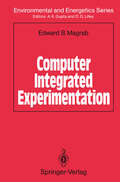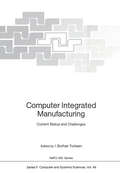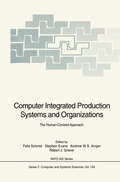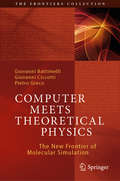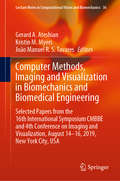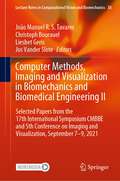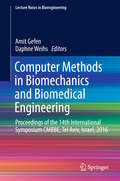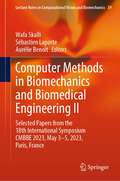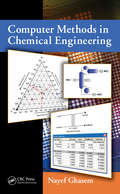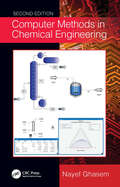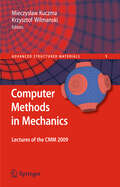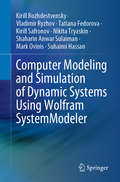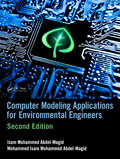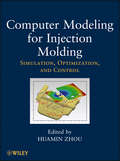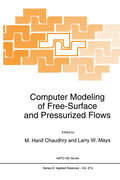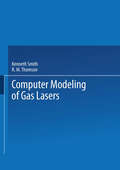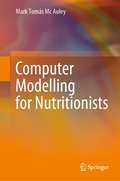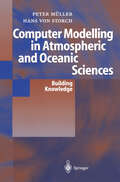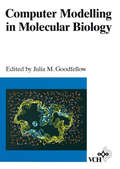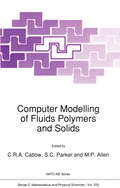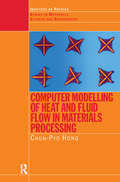- Table View
- List View
Computer Integrated Experimentation (Environmental and Energetics Series)
by Edward MagrabThis book provides a basis by which instruments and transducers can be selected, assembled and integrated with a computer to measure and control physical processes in an accurate and predictable manner. It consists of two parts, the first of which lays the theoretical foundation for the second. First the Fourier analysis of signals are summarized. Then, from a systems point of view, the following chapters introduce the important aspects of filters, amplifiers and analog-to-digital converters. The second half of the book first discusses in depth the importance of the timing of the computer with its instruments, transducers and actuators. It then summarizes the physical and functional aspects of transducers and actuators and gives numerous detailed examples of how they can be integrated into computer controlled experiments and processes.
Computer Integrated Manufacturing: Current Status and Challenges (NATO ASI Subseries F: #49)
by Kiyoji Asai Gunduz UlusoyThe Current state of expectations is that Computer Integrated Manufacturing (CIM) will ulti mately determine the industrial growth of world nations within the next few decades. Computer Aided Design (CAD), Computer Aided Manufacturing (CAM), Flexible Manufacturing Systems (FMS), Robotics together with Knowledge and Information Based Systems (KIBS) and Com munication Networks are expected to develop to a mature state to respond effectively to the managerial requirements of the factories of the future that are becoming highly integrated and complex. CIM represents a new production approach which will allow the factories to deliver a high variety of products at a low cost and with short production cycles. The new technologies for CIM are needed to develop manufacturing environments that are smarter, faster, close-cou pled, integrated, optimized, and flexible. Sophistication and a high degree of specialization in materials science, artificial intelligence, communications technology and knowledge-information science techniques are needed among others for the development of realizable and workable CIM systems that are capable of adjusting to volatile markets. CIM factories are to allow the production of a wide variety of similar products in small batches through standard but multi mission oriented designs that accommodate flexibility with specialized software.
Computer Integrated Production Systems and Organizations (NATO ASI Subseries F: #134)
by Felix Schmid Stephen Evans Andrew W. S. Ainger Robert J. GrieveThe Background to the Institute The NATO Advanced Study Institute (ASI) 'People and Computers - Applying an Anthropocentric Approach to Integrated Production Systems and Organisations' came about after the distribution of a NATO fact sheet to BruneI University, which described the funding of ASls. The 'embryonic' director of the ASI brought this opportunity to the attention of the group of people, (some at BruneI and some from outside), who were together responsible for the teaching and management of the course in Computer Integrated Manufacturing (CIM) in BruneI's Department of Manufacturing and Engineering Systems. This course had been conceived in 1986 and was envisaged as a vehicle for teaching manufacturing engineering students the technology of information integration through project work. While the original idea of the course had also included the organisational aspects of CIM, the human factors questions were not considered. This shortcoming was recognised and the trial run of the course in 1988 contained some lectures on 'people' issues. The course team were therefore well prepared and keen to explore the People, Organisation and Technology (POT) aspects of computer integration, as applied to industrial production. A context was proposed which would allow the inclusion of people from many different backgrounds and which would open up time and space for reflection. The proposal to organise a NATO ASI was therefore welcomed by all concerned.
Computer Meets Theoretical Physics: The New Frontier of Molecular Simulation (The Frontiers Collection)
by Giovanni Battimelli Giovanni Ciccotti Pietro GrecoThis book provides a vivid account of the early history of molecular simulation, a new frontier for our understanding of matter that was opened when the demands of theoretical physicists were met by the availability of the modern computers. Since their inception, electronic computers have enormously increased their performance, thus making possible the unprecedented technological revolution that characterizes our present times. This obvious technological advancement has brought with it a silent scientific revolution in the practice of theoretical physics. In particular, in the physics of matter it has opened up a direct route from the microscopic physical laws to observable phenomena. One can now study the time evolution of systems composed of millions of molecules, and simulate the behaviour of macroscopic materials and actually predict their properties. Molecular simulation has provided a new theoretical and conceptual tool that physicists could only dream of when the foundations of statistical mechanics were laid. Molecular simulation has undergone impressive development, both in the size of the scientific community involved and in the range and scope of its applications. It has become the ubiquitous workhorse for investigating the nature of complex condensed matter systems in physics, chemistry, materials and the life sciences. Yet these developments remain largely unknown outside the inner circles of practitioners, and they have so far never been described for a wider public. The main objective of this book is therefore to offer a reasonably comprehensive reconstruction of the early history of molecular simulation addressed to an audience of both scientists and interested non-scientists, describing the scientific and personal trajectories of the main protagonists and discussing the deep conceptual innovations that their work produced.
Computer Methods, Imaging and Visualization in Biomechanics and Biomedical Engineering: Selected Papers from the 16th International Symposium CMBBE and 4th Conference on Imaging and Visualization, August 14-16, 2019, New York City, USA (Lecture Notes in Computational Vision and Biomechanics #36)
by João Manuel R. S. Tavares Gerard A. Ateshian Kristin M. MyersThis book gathers selected, extended and revised contributions to the 16th International Symposium on Computer Methods in Biomechanics and Biomedical Engineering, and the 4th Conference on Imaging and Visualization (CMBBE 2019), held on August 14-16, 2019, in New York City, USA. It reports on cutting-edge models and algorithms for studying various tissues and organs in normal and pathological conditions; innovative imaging and visualization techniques; and the latest diagnostic tools. Further topics addressed include: numerical methods, machine learning approaches, FEM models, and high-resolution imaging and real-time visualization methods applied for biomedical purposes. Given the scope of its coverage, the book provides graduate students and researchers with a timely and insightful snapshot of the latest research and current challenges in biomedical engineering, computational biomechanics and biological imaging, as well as a source of inspiration for future research and cross-disciplinary collaborations.
Computer Methods, Imaging and Visualization in Biomechanics and Biomedical Engineering II: Selected Papers from the 17th International Symposium CMBBE and 5th Conference on Imaging and Visualization, September 7-9, 2021 (Lecture Notes in Computational Vision and Biomechanics #38)
by João Manuel R. S. Tavares Christoph Bourauel Liesbet Geris Jos Vander SloteThis book gathers selected, extended and revised contributions to the 17th International Symposium on Computer Methods in Biomechanics and Biomedical Engineering and the 5th Conference on Imaging and Visualization (CMBBE 2021), held online on September 7-9, 2021, from Bonn, Germany. It reports on cutting-edge models, algorithms and imaging techniques for studying cells, tissues and organs in normal and pathological conditions. It covers numerical and machine learning methods, finite element modeling and virtual reality techniques, applied to understand biomechanics of movement, fluid and soft tissue biomechanics. It also reports on related advances in rehabilitation, surgery and diagnosis. All in all, this book offers a timely snapshot of the latest research and current challenges at the interface between biomedical engineering, computational biomechanics and biological imaging. Thus, it is expected to provide a source of inspiration for future research and cross-disciplinary collaborations.
Computer Methods in Biomechanics and Biomedical Engineering: Proceedings of the 14th International Symposium CMBBE, Tel Aviv, Israel, 2016 (Lecture Notes in Bioengineering)
by Amit Gefen Daphne WeihsThis edited volume collects the research results presented at the 14th International Symposium on Computer Methods in Biomechanics and Biomedical Engineering, Tel Aviv, Israel, 2016. The topical focus includes, but is not limited to, cardiovascular fluid dynamics, computer modeling of tissue engineering, skin and spine biomechanics, as well as biomedical image analysis and processing. The target audience primarily comprises research experts in the field of bioengineering, but the book may also be beneficial for graduate students alike.
Computer Methods in Biomechanics and Biomedical Engineering II: Selected Papers from the 18th International Symposium CMBBE 2023, May 3-5, 2023, Paris, France (Lecture Notes in Computational Vision and Biomechanics #39)
by Wafa Skalli Sébastien Laporte Aurélie BenoitThis book gathers selected, extended and revised contributions to the 18th International Symposium on Computer Methods in Biomechanics and Biomedical Engineering, held on May 3-5, 2023, at Arts Et Métiers - Institute Of Technology, in Paris, France. They highlight cutting-edge advances in computational modelling in biomedical engineering, discusses new developments on imaging and visualization, as well as solutions for applying them in the clinical practice. All in all, this book offers a timely snapshot of the latest research and current challenges at the interface between biomedical engineering, computational biomechanics and biological imaging. It also aims at fostering future, cross-disciplinary collaborations.
Computer Methods in Chemical Engineering
by Nayef GhasemWhile various software packages have become quite useful for performing unit operations and other kinds of processes in chemical engineering, the fundamental theory and methods of calculation must also be understood in order to effectively test the validity of these packages and verify the results. Computer Methods in Chemical Engineering presents
Computer Methods in Chemical Engineering
by Nayef GhasemWhile various software packages have become essential for performing unit operations and other kinds of processes in chemical engineering, the fundamental theory and methods of calculation must also be understood to effectively test the validity of these packages and verify the results. Computer Methods in Chemical Engineering, Second Edition presents the most used simulation software along with the theory involved. It covers chemical engineering thermodynamics, fluid mechanics, material and energy balances, mass transfer operations, reactor design, and computer applications in chemical engineering. The highly anticipated Second Edition is thoroughly updated to reflect the latest updates in the featured software and has added a focus on real reactors, introduces AVEVA Process Simulation software, and includes new and updated appendixes. Through this book, students will learn the following: What chemical engineers do The functions and theoretical background of basic chemical engineering unit operations How to simulate chemical processes using software packages How to size chemical process units manually and with software How to fit experimental data How to solve linear and nonlinear algebraic equations as well as ordinary differential equations Along with exercises and references, each chapter contains a theoretical description of process units followed by numerous examples that are solved step by step via hand calculation and computer simulation using Hysys/UniSim, PRO/II, Aspen Plus, and SuperPro Designer. Adhering to the Accreditation Board for Engineering and Technology (ABET) criteria, the book gives chemical engineering students and professionals the tools to solve real problems involving thermodynamics and fluid-phase equilibria, fluid flow, material and energy balances, heat exchangers, reactor design, distillation, absorption, and liquid extraction. This new edition includes many examples simulated by recent software packages. In addition, fluid package information is introduced in correlation to the numerical problems in book. An updated solutions manual and PowerPoint slides are also provided in addition to new video guides and UniSim program files.
Computer Methods in Chemical Engineering
by Nayef GhasemWhile various software packages have become essential for performing unit operations and other kinds of processes in chemical engineering, the fundamental theory and methods of calculation must also be understood to effectively test the validity of these packages and verify the results. Computer Methods in Chemical Engineering, Second Edition presents the most used simulation software along with the theory involved. It covers chemical engineering thermodynamics, fluid mechanics, material and energy balances, mass transfer operations, reactor design, and computer applications in chemical engineering. The highly anticipated Second Edition is thoroughly updated to reflect the latest updates in the featured software and has added a focus on real reactors, introduces AVEVA Process Simulation software, and includes new and updated appendixes. Through this book, students will learn the following: What chemical engineers do The functions and theoretical background of basic chemical engineering unit operations How to simulate chemical processes using software packages How to size chemical process units manually and with software How to fit experimental data How to solve linear and nonlinear algebraic equations as well as ordinary differential equations Along with exercises and references, each chapter contains a theoretical description of process units followed by numerous examples that are solved step by step via hand calculation and computer simulation using Hysys/UniSim, PRO/II, Aspen Plus, and SuperPro Designer. Adhering to the Accreditation Board for Engineering and Technology (ABET) criteria, the book gives chemical engineering students and professionals the tools to solve real problems involving thermodynamics and fluid-phase equilibria, fluid flow, material and energy balances, heat exchangers, reactor design, distillation, absorption, and liquid extraction. This new edition includes many examples simulated by recent software packages. In addition, fluid package information is introduced in correlation to the numerical problems in book. An updated solutions manual and PowerPoint slides are also provided in addition to new video guides and UniSim program files.
Computer Methods in Mechanics: Lectures of the CMM 2009 (Advanced Structured Materials #1)
by Mieczyslaw Kuczma Krzysztof WilmanskiProminent scientists present the latest achievements in computational methods and mechanics in this book. These lectures were held at the CMM 2009 conference.
Computer Modeling and Simulation of Dynamic Systems Using Wolfram SystemModeler
by Kirill Rozhdestvensky Vladimir Ryzhov Tatiana Fedorova Kirill Safronov Nikita Tryaskin Shaharin Anwar Sulaiman Mark Ovinis Suhaimi HassanThis book briefly discusses the main provisions of the theory of modeling. It also describes in detail the methodology for constructing computer models of dynamic systems using the Wolfram visual modeling environment, SystemModeler, and provides illustrative examples of solving problems of mechanics and hydraulics. Intended for students and professionals in the field, the book also serves as a supplement to university courses in modeling and simulation of dynamic systems.
Computer Modeling Applications for Environmental Engineers
by Isam Mohammed Abdel-Magid Ahmed Mohammed Isam Mohammed Abdel-MagidComputer Modeling Applications for Environmental Engineers in its second edition incorporates changes and introduces new concepts using Visual Basic.NET, a programming language chosen for its ease of comprehensive usage. This book offers a complete understanding of the basic principles of environmental engineering and integrates new sections that address Noise Pollution and Abatement and municipal solid-waste problem solving, financing of waste facilities, and the engineering of treatment methods that address sanitary landfill, biochemical processes, and combustion and energy recovery. Its practical approach serves to aid in the teaching of environmental engineering unit operations and processes design and demonstrates effective problem-solving practices that facilitate self-teaching. A vital reference for students and professional sanitary and environmental engineers this work also serves as a stand-alone problem-solving text with well-defined, real-work examples and explanations.
Computer Modeling Applications for Environmental Engineers
by Isam Mohammed Abdel-Magid Ahmed Mohammed Isam Mohammed Abdel-MagidComputer Modeling Applications for Environmental Engineers in its second edition incorporates changes and introduces new concepts using Visual Basic.NET, a programming language chosen for its ease of comprehensive usage. This book offers a complete understanding of the basic principles of environmental engineering and integrates new sections that address Noise Pollution and Abatement and municipal solid-waste problem solving, financing of waste facilities, and the engineering of treatment methods that address sanitary landfill, biochemical processes, and combustion and energy recovery. Its practical approach serves to aid in the teaching of environmental engineering unit operations and processes design and demonstrates effective problem-solving practices that facilitate self-teaching. A vital reference for students and professional sanitary and environmental engineers this work also serves as a stand-alone problem-solving text with well-defined, real-work examples and explanations.
Computer Modeling for Injection Molding: Simulation, Optimization, and Control
by Huamin ZhouThis book covers a wide range of applications and uses of simulation and modeling techniques in polymer injection molding, filling a noticeable gap in the literature of design, manufacturing, and the use of plastics injection molding. The authors help readers solve problems in the advanced control, simulation, monitoring, and optimization of injection molding processes. The book provides a tool for researchers and engineers to calculate the mold filling, optimization of processing control, and quality estimation before prototype molding.
Computer Modeling for Injection Molding: Simulation, Optimization, and Control
by Huamin ZhouThis book covers a wide range of applications and uses of simulation and modeling techniques in polymer injection molding, filling a noticeable gap in the literature of design, manufacturing, and the use of plastics injection molding. The authors help readers solve problems in the advanced control, simulation, monitoring, and optimization of injection molding processes. The book provides a tool for researchers and engineers to calculate the mold filling, optimization of processing control, and quality estimation before prototype molding.
Computer Modeling of Free-Surface and Pressurized Flows (NATO Science Series E: #274)
by M. Hanif Chaudhry L. MaysComputers are widely used for the analysis, design, and operation of water resource projects. This gives accurate results, allowing the analysis of complex systems which may not have been possible otherwise, and the investigation and comparison of several different alternatives in a short time, thereby reducing the project costs, optimizing design, and efficient utilization of resources. This volume compiles an edited version of the lecture notes specially prepared by 14 well-known European and North American researchers. Part I deals with free-surface flows. Governing equations are derived and their solution by the finite-difference, finite-element, and boundary-integral methods are discussed. Then, turbulence models, three-dimensional models, dam-break flow models, sediment transport models, and flood routing models are presented. Part II is related to the modeling of steady and transient pressurized flows. Governing equations for both single and two-component flows are derived and numerical methods for their solution are presented. The modeling of water quality in pipe networks, of cooling water systems, and slow and rapid transients is then discussed.
Computer Modelling for Nutritionists
by Mark Tomás Mc AuleyThis book draws on Mark Mc Auley’s wealth of experience to provide an intuitive step-by-step guide to the modelling process. It also provides case studies detailing the creation of biological process models. Mark Mc Auley has over 15 years’ experience of applying computing to challenges in bioscience. Currently he is employed as a Senior Lecturer in Chemical Engineering at the University of Chester. He has published widely on the use of computer modelling in nutrition and uses computer modelling to both enhance and enrich the learning experience of the students that he teaches. He has taught computer modelling to individuals at a wide variety of levels and from different backgrounds, from undergraduate nutrition students to PhD and medical students.
Computer Modelling in Atmospheric and Oceanic Sciences: Building Knowledge
by Peter K. MüllerThe book describes what these models are, what they are based on, how they function, and then, most innovatively, how they can be used to generate new useful knowledge about the environmental system. Discusses this generation of knowledge by computer models from an epistemological perspective and illustrates it by numerous examples from applied and fundamental research. Includes ample technical appendices and is a valuable source of information for graduate students and scientists alike working in the field of environmental sciences.
Computer Modelling in Molecular Biology
by Julia M. GoodfellowThis book supplies an application-oriented introduction to molecular simulation techniques used to study a wide range of problems in molecular biology. Each chapter focuses in detail on one kind of application, including the scientific background, the appropriate methodology and the relationship to experimental results. The book contains many areas of interest to basic and industrial scientists, including: - flexibility of peptides - protein-peptide interactions - ion translocation across membranes - modelling protein and nucleic acid conformations - stability of mutant proteins - modelling conformational transitions Currently the only up-to-date compilation available, this book enables readers to get an overview of the methods and how they are used in various specialized applications without having to search for them in a large number of papers in different journals.
Computer Modelling of Fluids Polymers and Solids (Nato Science Series C: #293)
by Richard Catlow S. C. Parker M. P. AllenComputer Modelling techniques have developed very rapidly during the last decade, and interact with many contemporary scientific disciplines. One of the areas of greatest activity has concerned the modelling of condensed phases, including liquids solids and amorphous systems, where simulations have been used to provide insight into basic physical processes and in more recent years to make reliable predictions of the properties of the systems simulated. Indeed the predictive role of simulations is increasingly recognised both in academic and industrial contexts. Current active areas of application include topics as diverse as the viscosity of liquids, the conformation of proteins, the behaviour of hydrogen in metals, the diffusion of molecules in porous catalysts and the properties of micelles. This book, which is based on a NATO ASI held at the University of Bath, UK, from September 5th-17th, 1988, aims to give a general survey of this field, with detailed discussions both of methodologies and of applications. The earlier chapters of the book are devoted mainly to techniques and the later ones to recent simulation studies of fluids, polymers (including biological molecules) and solids. Special attention is paid to the role of interatomic potentials which are the fundamental physical input to simulations. In addition, developments in computer hardware are considered in depth, owing to the crucial role which such developments are playing in the expansion of the horizons of computer modelling studies.
Computer Modelling of Heat and Fluid Flow in Materials Processing
by C.P. HongThe understanding and control of transport phenomena in materials processing play an important role in the improvement of conventional processes and in the development of new techniques. Computer modeling of these phenomena can be used effectively for this purpose. Although there are several books in the literature covering the analysis of heat tra
Computer Modelling of Heat and Fluid Flow in Materials Processing
by C.P. HongThe understanding and control of transport phenomena in materials processing play an important role in the improvement of conventional processes and in the development of new techniques. Computer modeling of these phenomena can be used effectively for this purpose. Although there are several books in the literature covering the analysis of heat tra
